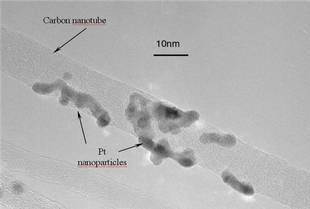| Diagnostics, nanotechnology | |||
Platinum-coated nanotube biosensor detects glucose in near real time21 March 2007 Researchers at the University of Arkansas have fabricated a novel biosensor that detects glucose in close to real time and with much greater sensitivity than other comparable, biocompatible sensors. The sensor, designed and developed by Jining Xie and researchers in the Department of Electrical Engineering, is made of multi-walled carbon nanotubes coated with platinum nanoparticles 1-5 nanometres in diameter. The researchers tested sensors with and without the platinum nanoparticles, and discovered that the carbon nanotubes with platinum exhibited a substantially higher sensitivity than those without platinum.
“To manage and control diabetes, patients must continuously monitor blood-glucose levels, so they understand the importance of a device that provides rapid response," said Jining Xie, research assistant professor of electrical engineering. "At this stage of the research, we believe that the improved electro-chemical performance is due to the platinum nanoparticles. We are currently investigating mechanisms to optimize this performance.” The research was carried out in the university’s Nanomaterials Research Laboratory by Xie and Vijay Varadan, Distinguished Professor of Electrical Engineering. Shouyan Wang, post-doctoral fellow, and Lavanya Aryasomayajula, graduate assistant, also contributed to the project. Tests revealed that for every square centimetre tested, a typical platinum-coated nanotube-based glucose sensor had a sensitivity of around 50 micro-amps per milimole (milimoles are a measure of molecular concentrations of glucose). The sensitivity value of the researchers’ device is among the best results reported for glucose biosensors. Xie said their goal is to further increase the sensitivity value of 52.7 micro-amps per milimole. Equally important, the biosensor has a response time of 15 to 30 seconds, which renders it capable of providing glucose screenings close to real time. The researchers attributed the improved sensibility to various factors related to the application of platinum to the multi-walled nanotubes. Most importantly, the platinum nanoparticles created a larger electro-active surface area on the carbon nanotubes. The larger surface area allowed the carbon nanotubes to act as a glucose-oxidase reservoir, which helped create uniform immobilization and high loading of glucose oxides for sensing. In addition, the platinum nanoparticles enhanced electron transfer and facilitated better physical and chemical bonding between glucose oxides and carbon nanotubes. The findings were published in the February issue of Nanotechnology, The article is available online. Professor Varadan said that there had been no previous research on the use of platinum nanoparticles coated on carbon nanotubes to develop a biosensor capable of detecting blood-glucose concentrations. The research is sponsored by NeoPharma Industries, which hopes to develop a commercial product by the end of 2007.
|
